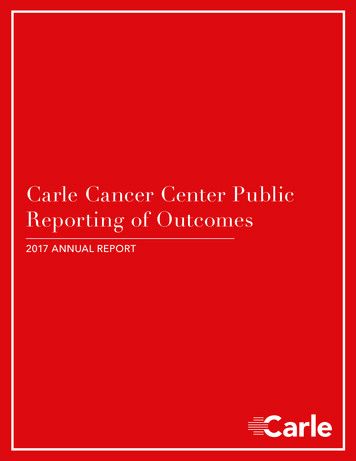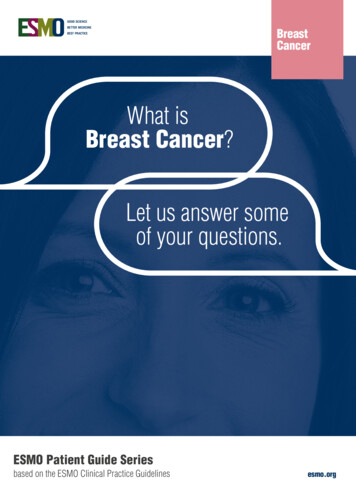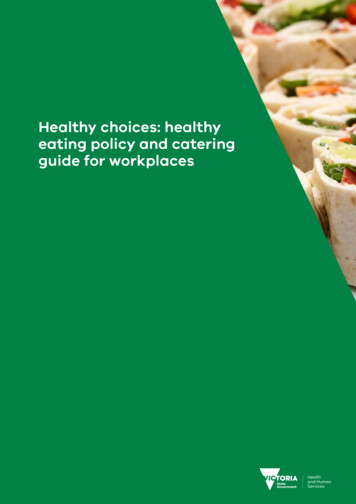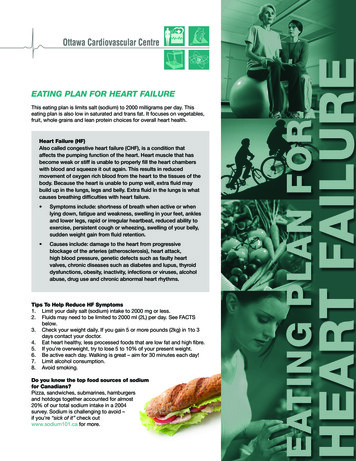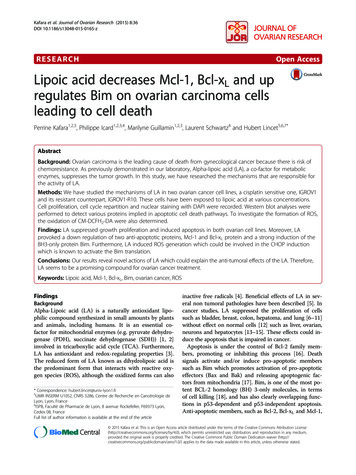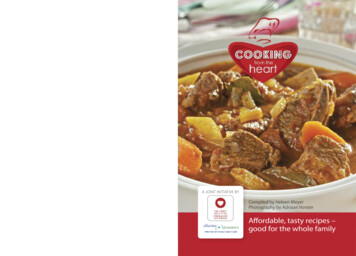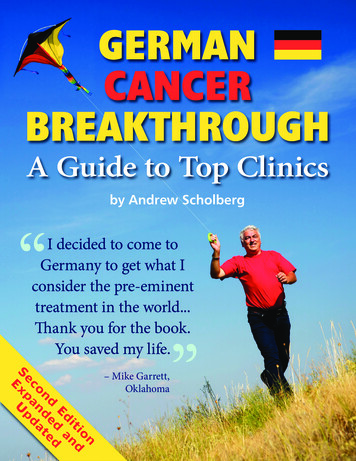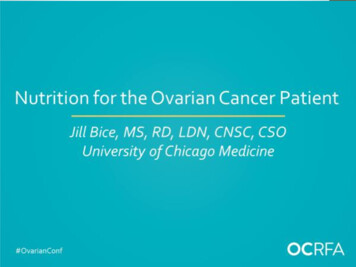
Transcription
Eating Healthy withOvarian CancerJill Bice, MS, RD, LDN, CNSC, CSO
Nutrition During Treatment Treatments for ovarian cancer can affect your body’s needs fornutrients. They can affect your eating habits and how yourbody digests, absorbs, and uses food. Your main nutritiongoals during this time are: Make certain your body’s nutrient & calorie goals are metMaintain a healthy weightAvoid losing muscleImprove the quality of your life as you go through treatmentAssure that any nutrient-related side effects are being preventedor managed as best they can
Nutrition During Treatment Chemotherapy is often considered the standard of care. Typically infused intravenously or through the abdominal cavity Common symptoms ovarian cancer patients often face thatmay impact nutrition: Nausea & Vomiting Anorexia Mucositis & Stomatitis Inflammation of the mouth Occasionally, sores in the mouth Diarrhea
Nutrition During Treatment Radiation Therapy is also a treatment option that yourphysician may have chosen Common symptoms that may impact nutrition Diarrhea Fatigue
Managing Symptoms Nausea and Vomiting Eat 5-6 small meals per dayLimit exposure to food smells by avoiding food preparation areasChoose cool, light foods with little odorAvoid greasy, high fat foodsConsume liquids between meals, rather than with mealsAvoid/limit strong smelling lotions, soaps, perfumes, airfresheners Rest with head elevated for 30 minutes after eating Take nausea medications as prescribed – eat when they areworking their best! Take pain medications with crackers or light foods
Managing Symptoms Anorexia – the loss of appetite or desire to eat Eat small, frequent meals of calorie dense foods and liquidsEat in pleasant surroundingsEat by the clock rather than waiting for hunger cuesView eating as a medicationNutrition supplements are an option!Engage in light physical activity to stimulate appetiteUse easy to prepare and serve foods to preserve energy
Managing Symptoms Mucositis Choose foods lower in acidity and avoid tomato products, citrusjuices and pickled foods Choose foods that are less spicy and avoid chili, chili powder,curry, cloves, black pepper and hot sauces Choose foods softer in texture with added moistness, sauce orgravy Choose cream soups, mashed potatoes, yogurt, eggs, tofu andpudding Serve foods at cool or room temperature Prepare smoothies with low acid fruits Melons, bananas, peaches Add yogurt, milk or silken tofu! Avoid alcohol and alcohol containing mouthwashes and tobacco
Managing Symptoms Diarrhea Identify problem foods or eating habitsEncourage a low fat, low fiber, and possibly a low lactose dietAvoid gas producing foods, caffeine and alcoholEncouraged small, frequent mealsAvoid sorbitol or other sugar-alcohol containing productsAvoid gas forming vegetables Onions, cruciferous vegetables Take 1-2 servings of psyllium husk daily or use Benefiber Mix scoop into warm water – drink before it cools!
Vitamin and MineralSupplements During Treatment Check with your health care provider before taking anyvitamin or mineral supplement while on treatments Some supplements can be useful if you have a specificdeficiency, but most studies have found that the risks of highdose supplements usually outweigh the benefits. Do not take a supplement that contains higher amounts than100% Daily Value (DV). The best way to get vitamins and minerals is from wholefoods, nutrient rich sources!
Diet During Treatment In general, a specific diet does not need to be followed.An overall healthy diet is best during treatmentsInclude plenty of fruits and vegetables in your dietInclude a source of lean protein at each mealIf nutrition issues or side effects arise you can make changesto your diet at that time
Transitioning If you have been following a strict diet during treatments tohelp manage your symptoms but are done and wanting toreturn to your regular diet, start slow Slowly add foods back into your diet Watch for signs/symptoms of distress Effects of your treatments do not stop the day of your finaltreatment
Nutrition After Treatments Get to and stay at a healthy weight You can work with professionals to achieve this goal Be active Eat a variety of healthy foods from plant sources Limit processed meat and red meat Eat 2 ½ cups or more of vegetables and fruit per day Choose whole grains rather than refined grains
A Healthy Weight Your Body Mass Index (BMI) can tell you if your weight isappropriate for your height You can find your BMI by using a chart at www.carcer.org(search for BMI) BMI for adults age 20 and older Underweight: BMI is less than 18.5Normal weight: BMI is 18.5 to 24.9Overweight: BMI is 25 to 29.9Obese: BMI is 30 or more
Get to a healthy weight General, healthy ways to control weight: Limit high calorie foodsDrink fewer beverages high in fat and/or added sugarEat more low-calorie foods like fruits and vegetablesAdd more physical activity throughout the dayTry this quiz from AICR: ow-healthy-isyour-diet.html?utm source mmenu
A Healthy Plate
Fruits In general, women should get 1 ½ to 2 cups of fruit per day Eat a variety of fruits Eating the whole fruit is better than drinking fruit juice
Vegetables In general, women should get 3 servings of non-starchyvegetables per day Eat a variety of vegetables Fresh or frozen vegetables are preferred over cannedvegetables
Phytochemicals What are phytochemicals? Phytochemicals naturally occur in plants – they provide color,odor and flavor. Phytochemicals have potential to: Stimulate the immune system Block substances we eat, drink and breathe from becomingcarcinogens Reduce inflammation that makes cancer growth more likely Prevent DNA damage and help with DNA repair Reduce the kind of oxidative damage to cells that can spark cancer Slow the growth rate of cancer cells Trigger damaged cells to die before they can reproduce Regulate hormones
Phytochemicals continued How to get these wonderful benefits: Make sure your diet is full of a variety of vegetables, fruits, wholegrains and beans Choose brightly colored or strongly flavored vegetables and fruits Get your phytochemicals from whole food sources They are best absorbed in this form as opposed to supplement form
Starches Aim to get ½ of your grains from whole grain source Whole grains have more fiber, iron and B vitamins Many Americans need to decrease their intake of starches ateach meal Whole grain sources would be: whole wheat flour, bulger,oatmeal, whole corn meal, and brown rice
Protein Foods Protein foods are: meat, poultry, seafood, beans and peas,eggs, processed soy products, nuts, and seeds Most healthy women aged 31 only need about 5 ounces ofprotein foods per day Try to choose lean protein selections as often as possible Try to incorporate seafood rich in omega-3 fatty acids Salmon, trout, sardines, anchovies, herring, Pacific oysters,Atlantic and Pacific mackerel Choose unsalted nuts and seeds to limit sodium intake
Dairy Good choices are: milk, yogurt, soy milk and cheeses Dairy is a good source of protein and calcium which are bothimportant for your health Look at the fat content of dairy products and count this intoyour daily fat intake if needed
Oils Women aged 31 years should limit oils to 5 teaspoons perday Healthy oil sources include Olive OilCoconut OilAvocado OilNut oilsSeed oils
Hydration In general, aim for 8 glasses of water per day Try to limit sugar sweetened beverages If you’re tired of drinking plain water there are many optionsyou could try! Add fruits or cucumber to water Try beverages like La Croix Drink decaffeinated, unsweetened tea
Portion SizesFOODSERVINGChopped Vegetables1 2 cupRaw Leafy Vegetables(such as lettuce)1 cupFresh FruitLOOKS LIKE1 2 baseball1 baseball or fist foraverage adult1 medium piece1 baseball1 2 cup chopped1 2 baseballDried Fruit1/4 cup1 golf ballPasta, Rice, CookedCereal1 2 cup1 2 baseballReady-to-Eat CerealRed Meat, Poultry,SeafoodDried Beans1 oz. varies from 1 4 cup toEMPTY CELL1¼ cups3 oz. (boneless cookedweight from 4 oz. raw)Deck of cards1 2 cup cooked1 2 baseballNuts1 3 cupLevel handful foraverage adultCheese1½ oz.4 dice or 2 9voltbatteriesSource: U.S. Department of Agriculture
Recipes! The American Institute for Cancer Research has many goodrecipes for you to try! http://www.aicr.org/healthyrecipes/
Frequently Asked Questions Can I take antioxidant supplements during treatment? During radiation and chemotherapy treatments most physiciansadvise against taking high doses of antioxidants. The supplementsmay interfere with or decrease the effectiveness of thetreatment. Cancer survivors should avoid taking dietary supplements thatcontain more than 100% of the Daily Value
Frequently Asked Questions What are the food safety precautions I should be following duringtreatments? Wash hands before eating or preparing foods Wash fruits and vegetables well Keep foods at the right temps Hot foods above 140 degrees Cold foods below 40 degrees Keep raw meats, seafood, poultry and eggs away from ready to eat foods Clean utensils, countertops, cutting boards and sponges that have contactwith raw meat well Cook foods to proper temperatures. Use a thermometer! Avoid raw honey, milk and fruit juice – choose pasteurized versions instead! When eating out – avoid salad bars, sushi and raw/undercooked meats, fish,poultry and eggs If you are concerned about the safety (purity) of the water in your home, askyour public health department to check it for bacteria Avoid getting food from the deli counter Avoid roasted nuts
Frequently Asked Questions Should I avoid meats? Limit red meats to less than 18 oz per week for prevention Eat processed meats only occasionally for cancer prevention Cooking high fat meats at a very high temperature can increaserisk of cancers No studies have looked at the effect of processed meat, meatcooked at high temps, or meat in general on cancer coming backor getting worse. A more plant based diet is associated with decreased risk ofcancers
Frequently Asked Questions What is the best thing I can do to prevent cancer returning orgrowing a new cancer? Maintaining or achieving a healthy body weight is the bestdefense against cancer. Increased body weight has been linked with higher death ratesfor all cancers combined. Avoid tobacco and alcohol. Eat a diet rich in fruits and vegetables.
Frequently Asked Questions Should I be eating Organic? “Organic” is often used for foods grown with limited pesticidesand genetic modifications/changes. It is also used for meat,poultry, eggs, and dairy products that come from animals that arenot given antibiotics or growth hormones. At this time, there are no studies in humans to show whetherorganic foods are better than other foods in reducing the risk ofcancer, the risk of cancer coming back, or the risk of cancerprogression. You can make your decision on what is best for you and yourfamily while this is continuing to be researched.
Frequently Asked Questions Does Sugar Feed Cancer? Sugar feeds ALL cells – cancerous and healthy If we do not eat enough carbohydrates from food our bodies willmake it in order to feed the cells. Making sugar will cause a loss in muscle and weaken our immunesystem – both are bad things when going through treatment!! Why do they feed you glucose to detect cancer on a PET scan? The glucose is feeding all cells in your body. It’s the hyperactivity ofthe cancer cell that is detected on the PET scan. Eating excess sugar is associated with weight gain. Obesity is arisk factor for cancer development.
Frequently Asked Questions Can I drink /diet/alcohol-and-cancer-risk.html
Suggestions for Finding aNutrition Professional Ask your health care team for a referral to see a registereddietitian (RD) if you have any nutrition-related challenges. Itwould be best if the RD is also a certified specialist in oncology(CSO). If an oncology dietitian is not available where you receive yourcancer treatment and care, ask about an appointment with adietitian at your primary care provider’s office, a clinic, or inyour community Visit the Academy of Nutrition and Dietetics’ website(www.eatright.org), using the “Find a Nutrition Professional”feature, type “Oncology Nutrition” in the expertise/specialtytab, or call the academy at 1-800-877-1600 to ask about aprivate practice dietitian in your area
References American Cancer Society’s “Lifestyle Changes that Make Difference”. Leser M, Ledesma N, Bergerson S, Trujillo E. Oncology Nutrition for Clinical Practice.2013. American Institute for Cancer Research. ntive-diet-model-plate.html. Accessed June 1, 2017. Choose My Plate. https://www.choosemyplate.gov/MyPlate. Accessed May 30, 2017. Mayo Foundation for Medical Education and Research. Positron emission tomography(PET) scan: Why it’s done. 2014; asics/why-its-done/prc-20014301, 2016.
Nutrition After Treatments Get to and stay at a healthy weight You can work with professionals to achieve this goal Be active Eat a variety of healthy foods from plant sources Limit processed meat and red meat Eat 2 ½ cups or more of vegetables and fruit per day Choose whole grains rather than refined grains Healthy Weight


